
The family Asteraceae, with the original name Compositae, consists of over 32,000 known species of flowering plants in over 1,900 genera within the order Asterales. Commonly referred to as the aster, daisy, composite, or sunflower family, Compositae were first described in the year 1740. The number of species in Asteraceae is rivaled only by the Orchidaceae, and which is the larger family is unclear as the quantity of extant species in each family is unknown.

Tarragon, also known as estragon, is a species of perennial herb in the family Asteraceae. It is widespread in the wild across much of Eurasia and North America and is cultivated for culinary and medicinal purposes.

Anise, also called aniseed or rarely anix is a flowering plant in the family Apiaceae native to the eastern Mediterranean region and Southwest Asia.
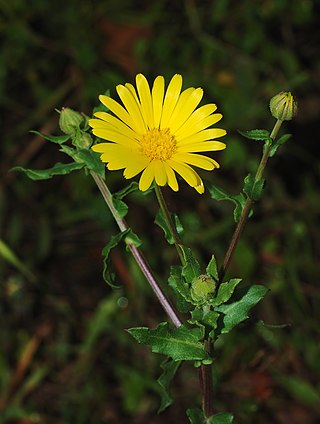
Calendula is a genus of about 15–20 species of annual and perennial herbaceous plants in the daisy family, Asteraceae that are often known as marigolds. They are native to southwestern Asia, western Europe, Macaronesia, and the Mediterranean. Other plants also known as marigolds, including corn marigold, desert marigold, marsh marigold, and plants of the genus Tagetes.
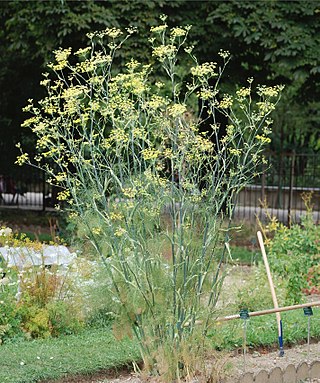
Fennel is a flowering plant species in the carrot family. It is a hardy, perennial herb with yellow flowers and feathery leaves. It is indigenous to the shores of the Mediterranean but has become widely naturalized in many parts of the world, especially on dry soils near the sea-coast and on riverbanks.
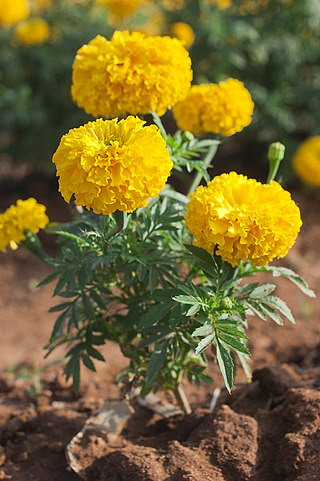
Tagetes is a genus of 50 species of annual or perennial, mostly herbaceous plants in the family Asteraceae. They are among several groups of plants known in English as marigolds. The genus Tagetes was described by Carl Linnaeus in 1753.

Tagetes tenuifolia, the signet marigold, golden marigold or lemon marigold, is a species of the wild marigold in the family Asteraceae. It is widespread across most of Mexico as well as Central America, Colombia, and Peru.
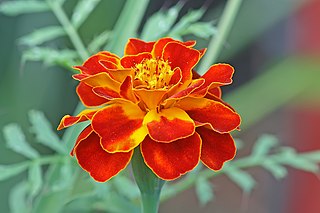
Tagetes patula, the French marigold, is a species of flowering plant in the family Asteraceae, native to Mexico and Guatemala with several naturalised populations in many other countries. It is widely cultivated as an easily grown bedding plant, with thousands of different cultivars in brilliant shades of yellow and orange.
Mexican marigold also known as cempasúchil, or Aztec marigold is a native flower to México and was first used by the Aztecs and is used in the Mexican holiday "Dia de los muertos" or day of the dead. Day of the dead originated from Aztec mythology to honor the Aztec goddess of death Mictēcacihuātl.

Thelesperma filifolium, commonly known as stiff greenthread, or plains greenthread, is a species of flowering plant in the aster family, Asteraceae. It is often found growing in shallow soils. It prefers disturbed sites in dry, sandy or gravelly soil with a neutral to basic pH. Stiff greenthread adapts to various soil conditions, including loam, clay, caliche, and roadsides. It blooms between March and June and often into the fall.

Tagetes erecta, the Aztec marigold, Mexican marigold, big marigold, cempazúchitl or cempasúchil, is a species of flowering plant in the genus Tagetes native to Mexico. Despite being native to the Americas, it is often called the African marigold. In Mexico, this plant is found in the wild in the states of México, Michoacán, Puebla, Veracruz and Guerrero
Porophyllum linaria is a sunny short-lived perennial plant used in Mexican cuisine, where it is often used to flavor meat dishes. It has a strong taste akin to fresh coriander with overtones of lemon and anise.

Calendula officinalis, the pot marigold, common marigold, ruddles, Mary's gold or Scotch marigold, is a flowering plant in the daisy family Asteraceae. It is probably native to southern Europe, though its long history of cultivation makes its precise origin unknown, and it may possibly be of garden origin. It is also widely naturalised farther north in Europe and elsewhere in warm temperate regions of the world.

Piper auritum is an aromatic culinary herb in the pepper family Piperaceae, which grows in tropical Central America. Common names include hoja santa, yerba santa, hierba santa, Mexican pepperleaf, acuyo, tlanepa, anisillo, root beer plant, Vera Cruz pepper and sacred pepper.

Tagetes minuta is a tall upright marigold plant from the genus Tagetes, with small flowers, native to the southern half of South America. Since Spanish colonization, it has been introduced around the world, and has become naturalized in Europe, Asia, Australasia, North America, and Africa. Tagetes minuta has numerous local names that vary by region. In the Andes it is known as Huacatay or Wacatay, and in other regions it is common as chinchilla, chiquilla, chilca, zuico, suico, or anisillo. Other names include muster John Henry, southern marigold, khakibos, stinking roger, wild marigold, and black mint. It is called by the Quechua terms huacatay in Peru or wakataya in Bolivia.

Porophyllum gracile is a species of flowering plant in the family Asteraceae known by the common names odora and slender poreleaf. It is native to northern Mexico and the southwestern United States from California to Texas, where it can be found in rocky and sandy desert scrub habitat.
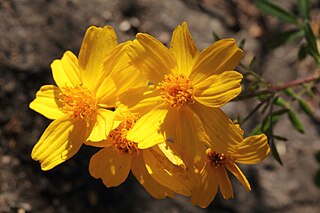
Tagetes lemmonii, or Lemmon's marigold, is a North American species of shrubby marigold, in the family Asteraceae. Other English names for this plant include Copper Canyon daisy, mountain marigold, and Mexican marigold.

Tagetes micrantha is a North American species of wild marigold within the family Asteraceae, common name licorice marigold. It is widespread across much of Mexico from Chihuahua to Oaxaca, and found also in the southwestern United States.
Tagetes stenophylla is a Mexican species of marigold in the family Asteraceae. It has been found in the States of Guerrero, Jalisco, Morelos, Michoacán, and México State in western and central Mexico.

















